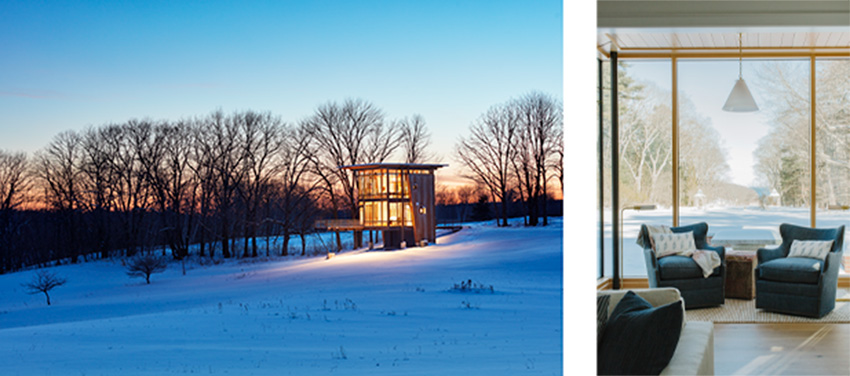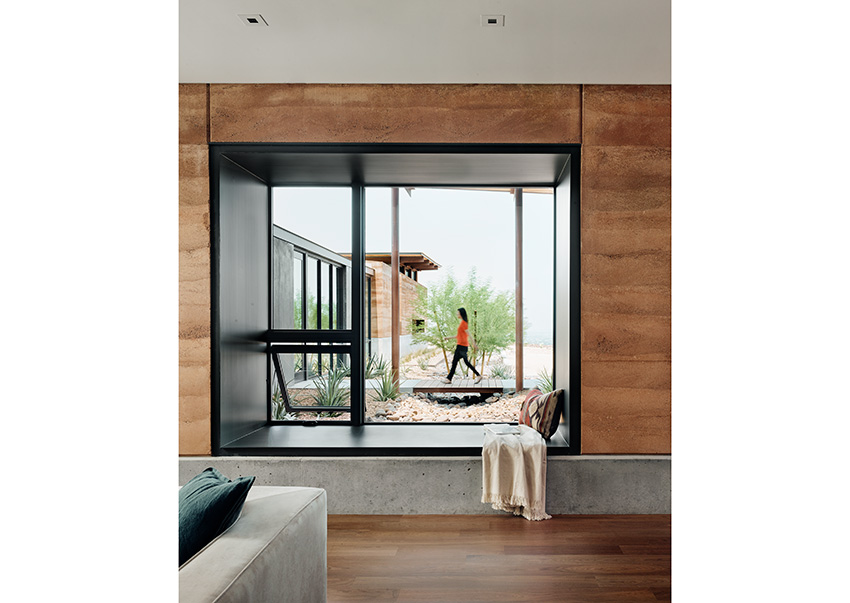Beyond Windows – Designing with Large- Format Glazing
Related to energy, the ENERGY STAR program administered by the US Department of Energy tests and rates window units, specifically to determine if they perform high enough above minimum standards to earn the ENERGY STAR label. The ENERGY STAR program does not conduct tests, rather it uses NFRC overall window thermal test results and assigns minimum criteria for each of the recognized geographical climate zones in the United States. Typically, ENERGY STAR ratings require at least 20 percent better performance than code minimum requirements. It does not consider AAMA Air, Water, and Structural test results.
The LEED Green Building Rating program is perhaps the best-known program for improving the energy performance and general sustainability of residential and commercial buildings. Windows and glazed fenestration products are not specifically identified with prescriptive performance requirements under LEED, but they play a key role in addressing overall energy use, daylight, and views – all of which are areas that have the potential to earn points toward LEED certification.
Another program growing in popularity is Passive House which is a voluntary standard resulting in ultra-low energy buildings requiring very little energy for space heating or cooling. In order to achieve that goal, all aspects of the thermal envelope are addressed including all fenestration. Typically, that means additional requirements on the windows or other glazed products for reduced heat transfer and air infiltration. In order to meet those requirements, manufacturers need to have the capability to produce very high-quality products.
In cases where a residence is subjected to potential extreme weather conditions, such as along a coast, structurally enhanced products are available that exceed the International Residential Code, the Florida Building Code, and other coastal standard requirements, such as the stringent Dade County certification. Such products are designed to endure hurricanes, tropical storms, high winds, driving rain, excessive heat, and even exceptional freezing conditions. These conditions are met through additional product engineering as well as including impact-resistant glazing. Wind-borne debris becomes a major concern during windstorms and hurricanes. To protect the integrity and interior of homes, windows, and doors must resist penetration and remain in place and intact when struck by this debris. Impact-designed laminated-glass windows and doors pass windborne debris impact tests. Even when broken, glass fragments remain attached to a composite interlayer between the laminations thus preserving the integrity of the building envelope during a storm. Many such glazing impact-resistant products are D-Missile certified meaning that they are tested to withstand impact from a 9-pound 2 x 4 stud, eight feet in length, at an impact speed of 50 feet per second. Products are then tested to withstand 9,000 positive and negative wind loading cycles without failure.

Photo: Nordlys Lodging - SALA Architects; Corey Gaffer Photography (left) Coastal Maine - Royer Architects; Meredith Brockington Photography (right); both courtesy of Loewen Windows and Doors
Windows and other glazing products can be specified to meet the demands of severe weather conditions in all climate zones.
Limitations
While everyone likes to think that anything is possible for glazed fenestration products, the reality is that there are some manufacturing and shipping limitations that need to be taken into account during design, especially for larger-sized units. These include the following factors:
- Glass Weight: Sometimes, heavier laminated glass is called for either to address security or resiliency concerns. Heavier glass means larger support members for the sash and frames. While that makes the products more robust and inherently stronger, it also means that they need to be properly integrated with the building construction in terms of depths, thicknesses, and sealing of edges, seams, etc.
- Preassembled Size: Many windows and other products can be combined together (i.e., “mulled”) or fabricated as a larger set of panels. However, there are practical limits on how large is too large to handle effectively in the field or to ship over the road. As a general rule, units up to 9 feet tall can be mulled together but the weight will be the limiting factor for what is practical to handle and install.
- Uniform Appearance: Many facade designs will incorporate different-sized fenestration products not only around a building but across the same wall. That would suggest that different thicknesses of glass or sashes are possible and may be considered. However, doing so can create some real design issues. First, the appearance of the different products can look notably different both along the exterior facade and the interior wall due to different sized sash and frames. Second, different thicknesses of glass can produce different visual clarity and visible light transmission when looking through them from inside the building. The best practice is to default to having all of the glazing components match the thickest or strongest product needed along a wall, if not the whole building.
Ultimately it is up to the manufacturer to provide all of the details about these different product characteristics and capabilities. Then it is the architect or designer’s role to select the products that best suit the design and performance needs of a project. With all of this in mind, we take a closer look at common options for standard and oversized glazing products in the following sections. Keep in mind that there are many different types of glazing products beyond standard windows, although those are touched on too. Many large or oversized products have become popular for design reasons and in response to owner requests. All of the products discussed need to meet performance requirements which can vary depending on location, owner requirements, or building type.

Photo: Horizon House – Lake Flato Architects; Casey Dunn Photography; courtesy of Loewen Windows and Doors
Awning windows are hinged at the top and allow for ventilation in the same manner as casement windows. They can be styled to suit either traditional or contemporary designs.
PUNCHED OPENING WINDOWS
Perhaps the most commonly used type of fenestration in residential buildings is “punched openings.” This term refers to the appearance of an opening being punched into the wall as a distinct opening. Typically, they are placed into the exterior structural walls and are the usual reference point for all other types of glazed products. These products are designed, installed, and purchased as distinct units in a variety of types and styles. They are commonly available in standard sizing patterns with custom sizing choices available in many cases. Manufacturers can usually accommodate different types of glass including double or triple glazing in some instances. The performance of punched windows varies based on their design and operation which are discussed further as follows:
Operable Windows
Most residential designs default to operable windows of one type or another since they provide the code-required natural ventilation in addition to daylight. The design appearance of operable windows can be selected from standard offerings in traditional or contemporary styles along with all of the general glazing design options discussed earlier. Operable windows can be equipped with insect screening as an add-on component. Some manufacturers also offer fully retractable screening which provides full visual clarity when the screen is coiled into a portion of the window frame. It operates by sliding along a track to cover the opening allowing the window to be open and protected from insects and then return to its concealed position when no longer needed.









